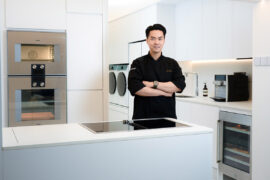With so many talented individuals and practices crowding our country’s A+D sector, how does one break through and gain global recognition? Well, it’s a matter of getting a helping hand!
As an emerging designer in what the world’s design hubs – London, Milan and Paris – often perceive as the other end of the earth, it can be tough for Aussies to get noticed. For even if you design a product that’s worthy of icon status in later years, how do you get it seen by the right pair of eyes in the first place? Unfortunately success is not just about what you know but (much of the time) who you know and the A+D industry is no exception, particularly when it comes to accessing global platforms for your creations.
This is why it’s so important for larger manufacturers and prominent designers to give back to the industry that has buoyed their own success, by initiating schemes that foster the next generation of talent. One company who recognises this is Haworth – a word leader in the commercial furniture market. This year it hosted the Celebrating Great Design Contest, which invites design professionals from Asia Pacific, Middle East and Africa to submit a design concept, with the winning team or individual eventually seeing their design manufactured and brought to market.
As part of the prize this year, the winning team was whisked off to Milan where they workshopped their concept with none other than Studio Urquiola! This was followed up by a trip to Shanghai, for prototyping with the Haworth Design Team, and finally a launch event in Sydney earlier this year, where the team toasted their success and unveiled their finished product to the A+D world.
The calibre of entries was incredibly high but the judging panel, which included Patricia Urquiola and Haworth’s Nicolai Czumaj-Bront and David Barrass, eventually awarded the prize to a team comprising three interior designers (Jess Dootjes, Brittany Pearce and Sue Fenton) and one architect / product designer (Josh Carmody) from Melbourne – all of whom have worked extensively in Woods Bagot’s workplace sector.
All contestants were challenged with conceptualising a piece of furniture or setting that would enhance collaborative behaviour in the workspace and the winning team responded with Penumbra; a highly practical and ergonomic range of organic-shaped furniture that, with its free flowing-lines, simplicity of form and different sizes, encourage people to gather, perch and linger in casual meeting.
As winner Josh Carmody explains, the concept for the winning design – Penumbra – was partly inspired by two large, standing-height tables that he designed for Woods Bagot’s Melbourne studio in early 2016. “I had paid particular interest to the rapid change in work practices that emerged with the arrival of these two tables,” he explained to Indesign. “ With no prompting, many people in the studio began holding meetings around these tables and other people began using these tables for marking up drawings. Previously these tasks would happen seated in meeting rooms and at desks.”
As such, various-height tables became a major focus of the winning range, complemented by a selection of acoustic screens, lighting and stools to form relaxed meeting areas and break-out zones.
On the subject of the team’s prize, Josh says: “As an independent furniture designer and maker based in Melbourne, working with larger furniture companies (such as Haworth) seemed a distant dream and working with design icons, and one of my idols, Patricia Urquiola, in her studio in Milan seemed equally unattainable! Presenting a range of furniture to her and her team was a surreal experience and a career highlight to say the least.”
Indeed, as an emerging designer in today’s crowded marketplace, what an amazing coup to have your design not just applauded but workshopped by Urquiola. “I think Penumbra was a fantastic project because there were few elements – it was simple in some ways but then also complex in a way,” she says. “It also showed a very open attitude to understanding the space in which we work and the items we use… when I have to describe what is good design, for me it is a lot to do with the intention of the project… if we get an attitude that is open to breaking prejudices.”
During the workshopping process, Josh reflects on how there were a lot of ideas to process in a very short time, as Studio Urquiola looked at various ways to interpret their concept and work out what was important, what wasn’t and what could potentially be changed. Urquiola encouraged her visitors to “remain consistent and strong and defend what they believe in… even if, in the process, we are going to look at approaching it in different ways… but at the same time to be open to simplifying the process.”
Not surprisingly, this was welcome advice. Josh elaborates: “Patricia pointed out that there were some symbolisms within the range that we could let go of without hindering our original design intentions and this change was a major breakthrough; lifting a layer of complexity from the range and allowing each product the space and presence they each deserve, while also simplifying the user experience.”
The final Penumbra range embodies everything Haworth set out to achieve with this competition: A beautiful collection of furniture that promotes collaboration within the modern-day office? Tick. A chance to engage with today’s designers and better understand the brilliant ideas that are born every day? Tick. The ability to nurture our next generation of designers by giving them a global platform for their ideas? Tick again. And rapturous applause for everyone involved in the scheme – especially Haworth, the judges and the winning team!
INDESIGN is on instagram
Follow @indesignlive
A searchable and comprehensive guide for specifying leading products and their suppliers
Keep up to date with the latest and greatest from our industry BFF's!

Now cooking and entertaining from his minimalist home kitchen designed around Gaggenau’s refined performance, Chef Wu brings professional craft into a calm and well-composed setting.

Sydney’s newest design concept store, HOW WE LIVE, explores the overlap between home and workplace – with a Surry Hills pop-up from Friday 28th November.

Merging two hotel identities in one landmark development, Hotel Indigo and Holiday Inn Little Collins capture the spirit of Melbourne through Buchan’s narrative-driven design – elevated by GROHE’s signature craftsmanship.

Designed by Woods Bagot, the new fit-out of a major resources company transforms 40,000-square-metres across 19 levels into interconnected villages that celebrate Western Australia’s diverse terrain.

Across four decades, Leone Lorrimer LFRAIA GAICD reshaped Australian architecture through strategic vision, global influence and fearless leadership.

Central Station by Woods Bagot in collaboration with John McAslan + Partners has been named one of two joint winners of The Building category at the INDE.Awards 2025. Recognised alongside BVN’s Sirius Redevelopment, the project redefines Sydney’s historic transport hub through a transformative design that connects heritage with the demands of a modern, growing city.
The internet never sleeps! Here's the stuff you might have missed

Arranged with the assistance of Cult, Marie Kristine Schmidt joins Timothy Alouani-Roby at The Commons in Sydney.

The Commons opens new Sydney and Melbourne locations by DesignOffice, blending hospitality, design and community.